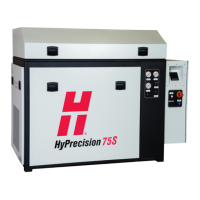Safety and compliance SC-15
Product stewardship
Product stewardship
Differences in national standards
Nations can apply different performance, safety, or other standards. National differences in standards include, but
are not limited to:
Voltages
Plug and cord ratings
Language requirements
Electromagnetic compatibility requirements
These differences in national or other standards can make it impossible or impractical for all certification test
marks to be put on the same version of a product. For example, the Canadian Standards Association (CSA)
versions of Hypertherm’s products do not comply with European electromagnetic compatibility requirements and
therefore do not have a CE mark on the data plate.
Countries that require a CE mark or have compulsory electromagnetic compatibility regulations must use CE
versions of Hypertherm products with the CE mark on the data plate. These may include, but are not limited to:
Countries in the European Union
Australia
New Zealand
Russia
It is important that the product and its certification test mark be suitable for the end-use installation site. When
Hypertherm products are shipped to one country for export to a different country, the product must be configured
and certified properly for the end-use installation site.
Higher-level systems
When an original equipment manufacturer (OEM) or a system integrator adds equipment such as cutting tables,
motor drives, motion controllers, or robots to a Hypertherm waterjet cutting system, the combined system is
considered a higher-level system. A higher-level system with hazardous moving parts can constitute industrial
machinery or robotic equipment, in which case the OEM, system integrator, or end-use customer can be subject
to more regulations and standards than those applicable to the waterjet cutting system manufactured by
Hypertherm.
It is the responsibility of the end-use customer and the OEM or system integrator to do a risk assessment for the
higher-level system and to provide protection against hazardous moving parts. Unless the higher-level system is
certified when the OEM or system integrator incorporates Hypertherm products into it, the installation can be
subject to approval by local authorities. Seek advice from legal counsel and local regulatory experts if you are
uncertain about compliance.
External interconnecting cables between parts of the higher-level system must be suitable for exposure to
contaminants and movement as required by the final end-use installation site. When the external interconnecting
cables are subject to exposure to oil, dust, water, or other contaminants, hard usage ratings can be required.
When external interconnecting cables are subject to continuous movement, constant flexing ratings can be
required. It is the responsibility of the OEM, system integrator, or end-use customer to make sure that external
interconnecting cables are suitable for the application and comply with all federal, state, and local regulations.

